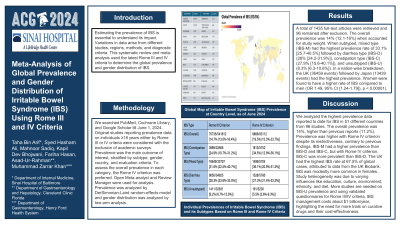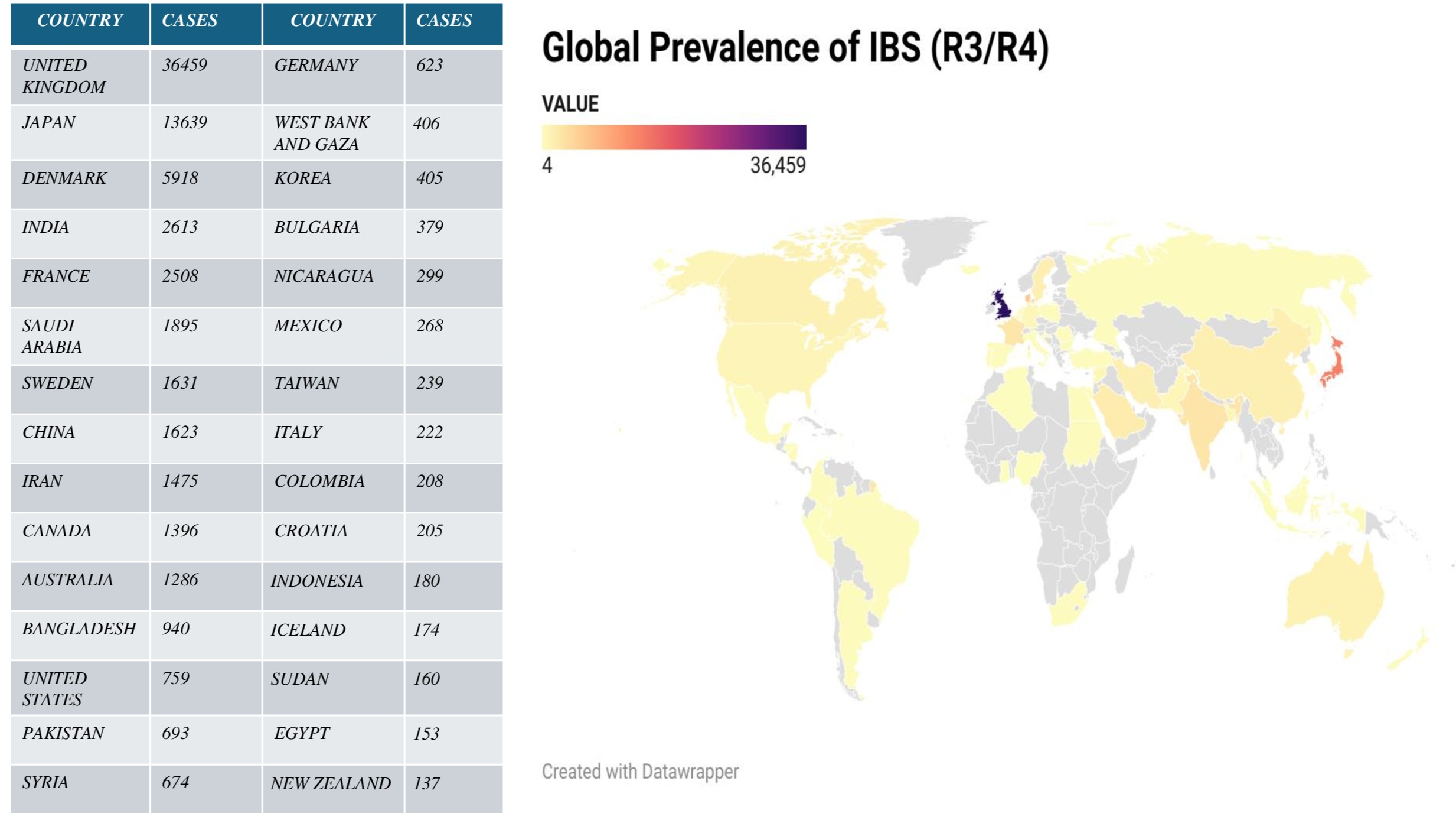Sunday Poster Session
Category: Functional Bowel Disease
P0635 - Meta-Analysis of Global Prevalence and Gender Distribution of Irritable Bowel Syndrome (IBS) Using Rome III and IV Criteria
Sunday, October 27, 2024
3:30 PM - 7:00 PM ET
Location: Exhibit Hall E

Has Audio

Taha Bin Arif, MBBS, MD
Sinai Hospital
Baltimore, MD
Presenting Author(s)
Taha Bin Arif, MBBS, MD1, Syed Hasham Ali, MBBS2, Mahnoor Sadiq, MBBS2, Kapil Dev Bhojwani, MBBS3, Fariha Hasan, MD4, Asad Ur Rahman, MD5, Muhammad Zarrar Khan, MD6
1Sinai Hospital, Baltimore, MD; 2Dow Medical College, Karachi, Sindh, Pakistan; 3Dow University of Health Sciences, Karachi, Sindh, Pakistan; 4Cooper University Hospital, Camden, NJ; 5Cleveland Clinic Florida, Weston, FL; 6Henry Ford Hospital, Royal Oak, MI
Introduction: Estimating the prevalence of IBS is essential to understand its impact. Variations in data arise from different studies, regions, methods, and diagnostic criteria. This systematic review and meta-analysis used the latest Rome III and IV criteria to determine the global prevalence and gender distribution of IBS.
Methods: We searched PubMed, Cochrane Library, and Google Scholar till June 1, 2024. Original studies reporting prevalence data on individuals ≥18 years either by Rome III or IV criteria were considered with the exclusion of academic surveys. Prevalence was the main outcome of interest, stratified by subtype, gender, country, and evaluation criteria. To assess the overall prevalence in each category, the Rome IV criterion was preferred. Open Meta-analyst and Review Manager were used for analysis. Prevalence was analyzed by DerSimonian-Laird random-effects model and gender distribution was analyzed by two-arm analysis.
Results: A total of 1435 full-text articles were retrieved and 96 remained after exclusion. The overall prevalence was 14% (12.1-16%) when accounted for study weight. When subtyped, mixed type (IBS-M) had the highest prevalence rate of 33.1% [25.7-40.5%] followed by diarrhea type (IBS-D) (28% [24.2-31.9%]), constipation type (IBS-C) (27.9% [15.6-40.1%]), and unsubtyped (IBS-U) (8.3% [6.3-10.6%]). In a nation-wise breakdown, the UK (36459 events) followed by Japan (13439 events) had the highest prevalence. Women were found to have a higher rate of IBS compared to men (OR 1.49, 95% CI [1.24-1.79]), p < 0.00001).
Discussion: We analyzed the highest prevalence data reported to date for IBS in 51 different countries from 96 studies. The overall prevalence was 14%, higher than previous reports (11.2%). Prevalence was higher with Rome IV criterion despite its restrictiveness, contrary to previous findings. IBS-M had a higher prevalence than IBS-D and IBS-C, but with Rome IV criterion, IBS-C was more prevalent than IBS-D. The UK had the highest IBS rate at 67.5% of global cases, attributed to data from the UK Biobank. IBS was modestly more common in females. Study heterogeneity was due to varying influences like education, culture, environment, ethnicity, and diet. More studies are needed on IBS-U prevalence and using validated questionnaires for Rome III/IV criteria. IBS management costs about $1 billion/year, highlighting the need for more trials on curative drugs and their cost-effectiveness, especially for the IBS-M subtype.

Note: The table for this abstract can be viewed in the ePoster Gallery section of the ACG 2024 ePoster Site or in The American Journal of Gastroenterology's abstract supplement issue, both of which will be available starting October 27, 2024.
Disclosures:
Taha Bin Arif, MBBS, MD1, Syed Hasham Ali, MBBS2, Mahnoor Sadiq, MBBS2, Kapil Dev Bhojwani, MBBS3, Fariha Hasan, MD4, Asad Ur Rahman, MD5, Muhammad Zarrar Khan, MD6. P0635 - Meta-Analysis of Global Prevalence and Gender Distribution of Irritable Bowel Syndrome (IBS) Using Rome III and IV Criteria, ACG 2024 Annual Scientific Meeting Abstracts. Philadelphia, PA: American College of Gastroenterology.
1Sinai Hospital, Baltimore, MD; 2Dow Medical College, Karachi, Sindh, Pakistan; 3Dow University of Health Sciences, Karachi, Sindh, Pakistan; 4Cooper University Hospital, Camden, NJ; 5Cleveland Clinic Florida, Weston, FL; 6Henry Ford Hospital, Royal Oak, MI
Introduction: Estimating the prevalence of IBS is essential to understand its impact. Variations in data arise from different studies, regions, methods, and diagnostic criteria. This systematic review and meta-analysis used the latest Rome III and IV criteria to determine the global prevalence and gender distribution of IBS.
Methods: We searched PubMed, Cochrane Library, and Google Scholar till June 1, 2024. Original studies reporting prevalence data on individuals ≥18 years either by Rome III or IV criteria were considered with the exclusion of academic surveys. Prevalence was the main outcome of interest, stratified by subtype, gender, country, and evaluation criteria. To assess the overall prevalence in each category, the Rome IV criterion was preferred. Open Meta-analyst and Review Manager were used for analysis. Prevalence was analyzed by DerSimonian-Laird random-effects model and gender distribution was analyzed by two-arm analysis.
Results: A total of 1435 full-text articles were retrieved and 96 remained after exclusion. The overall prevalence was 14% (12.1-16%) when accounted for study weight. When subtyped, mixed type (IBS-M) had the highest prevalence rate of 33.1% [25.7-40.5%] followed by diarrhea type (IBS-D) (28% [24.2-31.9%]), constipation type (IBS-C) (27.9% [15.6-40.1%]), and unsubtyped (IBS-U) (8.3% [6.3-10.6%]). In a nation-wise breakdown, the UK (36459 events) followed by Japan (13439 events) had the highest prevalence. Women were found to have a higher rate of IBS compared to men (OR 1.49, 95% CI [1.24-1.79]), p < 0.00001).
Discussion: We analyzed the highest prevalence data reported to date for IBS in 51 different countries from 96 studies. The overall prevalence was 14%, higher than previous reports (11.2%). Prevalence was higher with Rome IV criterion despite its restrictiveness, contrary to previous findings. IBS-M had a higher prevalence than IBS-D and IBS-C, but with Rome IV criterion, IBS-C was more prevalent than IBS-D. The UK had the highest IBS rate at 67.5% of global cases, attributed to data from the UK Biobank. IBS was modestly more common in females. Study heterogeneity was due to varying influences like education, culture, environment, ethnicity, and diet. More studies are needed on IBS-U prevalence and using validated questionnaires for Rome III/IV criteria. IBS management costs about $1 billion/year, highlighting the need for more trials on curative drugs and their cost-effectiveness, especially for the IBS-M subtype.

Figure: Figure 1: Global Map of Irritable Bowel Syndrome (IBS) Prevalence at Country Level, as of June, 2024.
Note: The table for this abstract can be viewed in the ePoster Gallery section of the ACG 2024 ePoster Site or in The American Journal of Gastroenterology's abstract supplement issue, both of which will be available starting October 27, 2024.
Disclosures:
Taha Bin Arif indicated no relevant financial relationships.
Syed Hasham Ali indicated no relevant financial relationships.
Mahnoor Sadiq indicated no relevant financial relationships.
Kapil Dev Bhojwani indicated no relevant financial relationships.
Fariha Hasan indicated no relevant financial relationships.
Asad Ur Rahman: Abbvie – Speakers Bureau.
Muhammad Zarrar Khan indicated no relevant financial relationships.
Taha Bin Arif, MBBS, MD1, Syed Hasham Ali, MBBS2, Mahnoor Sadiq, MBBS2, Kapil Dev Bhojwani, MBBS3, Fariha Hasan, MD4, Asad Ur Rahman, MD5, Muhammad Zarrar Khan, MD6. P0635 - Meta-Analysis of Global Prevalence and Gender Distribution of Irritable Bowel Syndrome (IBS) Using Rome III and IV Criteria, ACG 2024 Annual Scientific Meeting Abstracts. Philadelphia, PA: American College of Gastroenterology.
